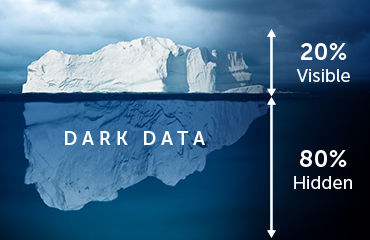By Des Nnochiri
The concept of dark data is only just starting to gain prominence in IT circles. However, there is still a lot of confusion as to just what the term refers to, and the nature of the challenges and opportunities presented by the phenomenon.
Dark Data?
 Dark Data refers to any digital information which has been collected, processed and stored by an organization as part of its regular business activity, but is not used for any other purpose. Dark data can go unused for practical reasons. For example, by the time it’s been processed, data may be outdated and therefore no longer fit for its originally intended purpose. Alternatively, records may be incomplete, incorrectly parsed, or stored in formats which have since become obsolete.
Dark Data refers to any digital information which has been collected, processed and stored by an organization as part of its regular business activity, but is not used for any other purpose. Dark data can go unused for practical reasons. For example, by the time it’s been processed, data may be outdated and therefore no longer fit for its originally intended purpose. Alternatively, records may be incomplete, incorrectly parsed, or stored in formats which have since become obsolete.
More recently, dark data has become associated with big and operational data, such as sever logs which contain information on everything including website visitor behavior, call records, customer sentiment data, and mobile geolocation information.
However, far from being useless or benign, dark data can present unique challenges and indeed opportunities for businesses with the initiative to address them.
Challenge – GDPR
The new GDPR![]() regulations due to be introduced by the European Union
regulations due to be introduced by the European Union![]() (EU) on the 25th May 2018 are set to cause significant disruption to any business which holds data on any citizen of its 28 member states
(EU) on the 25th May 2018 are set to cause significant disruption to any business which holds data on any citizen of its 28 member states![]() . Even if the company in question is not based in a country which is an EU member, if they hold data on EU citizens, then the rules will apply to them.
. Even if the company in question is not based in a country which is an EU member, if they hold data on EU citizens, then the rules will apply to them.
With new rules![]() covering territorial scope, penalties, consent, breach notification, right to access, right to be forgotten, data portability, privacy, data protection officers, and more, the GDPR may be the catalyst which gets companies to look at their dark data with fresh eyes.
covering territorial scope, penalties, consent, breach notification, right to access, right to be forgotten, data portability, privacy, data protection officers, and more, the GDPR may be the catalyst which gets companies to look at their dark data with fresh eyes.
Whereas before dark data could be squirreled away in excess storage facilities and forgotten about, this will not be the case in a post-GDPR data landscape – especially when it comes to unstructured data. When GDPR comes into force, data is only permitted to be stored if it is of reasonable and practical use to the company holding it, otherwise it must be deleted. With unstructured data – for example, a scanned passport in the file of a former employee – there are significant challenges with locating and deleting it. Therefore, the sudden need to remove it – whether through compliance updates or subject requests – can result in significant man hours lost in its location.
This means companies would do well to get their dark data in order ahead of time, so they’re ready to tackle the challenges of GDPR by the time May 25th comes around.
Opportunity – Better Customer Service
When looking to leverage opportunity from the modern data hoarding culture the key to success can be found in the common denominator between existing “useful” technologies and presently unused dark data – the customer.
The subject of the data should be the focus of any discussion on how to make the most of it. One can then look at the data being held, disregard its originally intended use, and start to come up with applications to give it a new lease of life.
For example, customer churn data could be analyzed to deduce the motivations of customers who have departed your business, and used to drive innovative engagement strategies, as opposed to generic one size fits all “missing you” type emails. At the other end of the customer journey, registration data can be used to create detailed customer profiles and more deeply personalized marketing communications.
Hover data tells a company how many customers hover their cursor over a link and how long they hover for without clicking on it. While this data may seem dark on the surface of it, it can give insights into the differences in motivation of someone who hovers over a link compared to someone who, say, adds an item to their cart and then abandons it.
“Even within a current system, such as a content management system, a marketer can ask, ‘When does a typical consumer disengage?’ and then search for patterns across various consumer actions, using data that is often overlooked,” writes BounceX![]() Senior Director of Product Innovation, Steven Dong
Senior Director of Product Innovation, Steven Dong![]() . “For instance, a publisher could access online site activity data to see at what point people leave their pages across various template types, or a marketer could find that consumers leave a page when there are too many product choices or when the font is too small.”
. “For instance, a publisher could access online site activity data to see at what point people leave their pages across various template types, or a marketer could find that consumers leave a page when there are too many product choices or when the font is too small.”
Final Thoughts
Dark data is only set to become more relevant to businesses when the new GDPR regulations come into play. Companies will need to adopt a use it or lose it philosophy to their stored information once the new rules are in force, and both options will require insight, innovation, and no small amount of hard work to bring dark data into the light.

